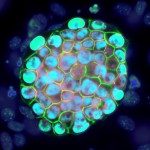Link to Pubmed [PMID] – 23733391
Stem Cells 2013 Sep;31(9):1932-41
At the end of the preimplantation period, the inner cell mass (ICM) of the mouse blastocyst is composed of two distinct cell lineages, the pluripotent epiblast (EPI) and the primitive endoderm (PrE). The current model for their formation involves initial co-expression of lineage-specific markers followed by mutual-exclusive expression resulting in a salt-and-pepper distribution of lineage precursors within the ICM. Subsequent to lineage commitment, cell rearrangements and selective apoptosis are thought to be key processes driving and refining the emergence of two spatially distinct compartments. Here, we have addressed a role for Platelet Derived Growth Factor (PDGF) signaling in the regulation of programmed cell death during early mouse embryonic development. By combining genetic and pharmacological approaches, we demonstrate that embryos lacking PDGF activity exhibited caspase-dependent selective apoptosis of PrE cells. Modulating PDGF activity did not affect lineage commitment or cell sorting, suggesting that PDGF is involved in the fine-tuning of patterning information. Our results also indicate that PDGF and fibroblast growth factor (FGF) tyrosine kinase receptors exert distinct and non-overlapping functions in PrE formation. Taken together, these data uncover an early role of PDGF signaling in PrE cell survival at the time when PrE and EPI cells are segregated.
